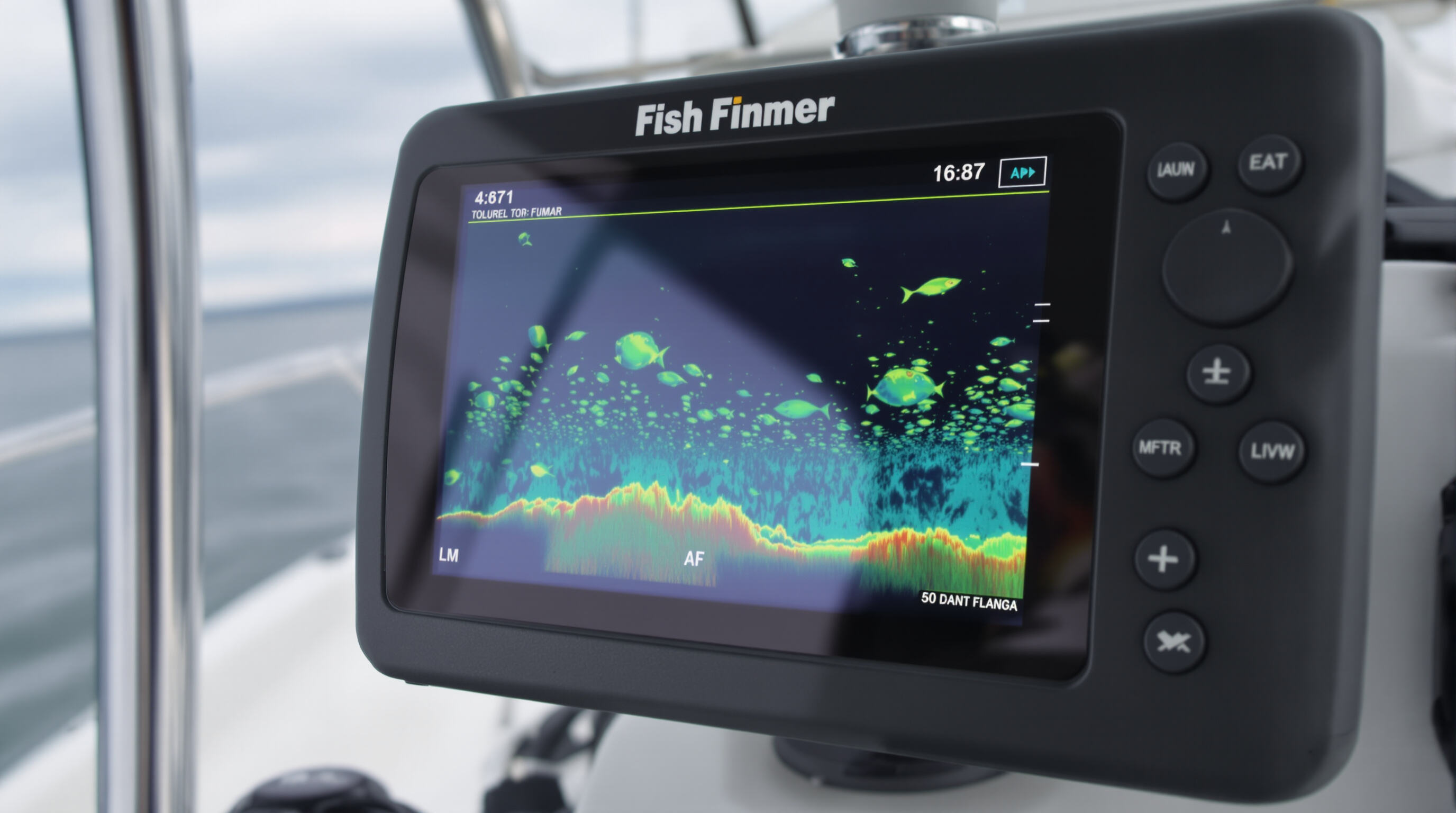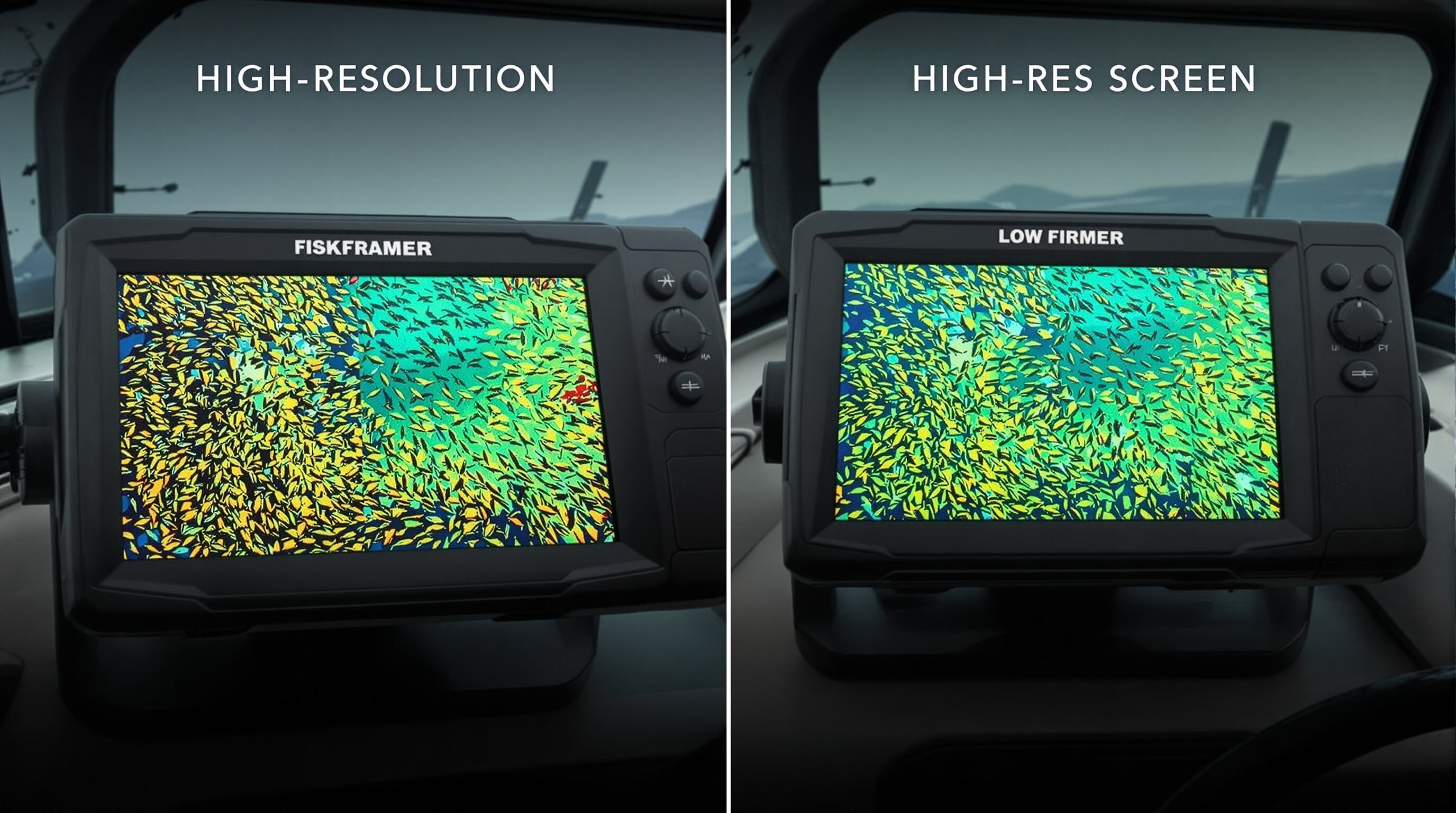Sonar Display Technology and Its Impact on Imaging Precision

Today's fish finder screens rely on sophisticated sonar tech to turn those confusing sound waves into pictures we can actually see under the water. Take CHIRP sonar for instance – it stands for Compressed High-Intensity Radar Pulse. This system sends out changing frequencies instead of regular pulses, which cuts down on background noise and makes it easier to tell different objects apart beneath the surface. According to MarineTech Journal from last year, this approach gives anglers about 40% better clarity than older systems. The latest developments are even tackling tricky underwater issues like how light gets absorbed or particles floating around mess with visibility. These improvements mean fishermen now get images that show fish shapes and bottom details about 25% clearer than before, making all the difference when trying to spot what's lurking below.
The Importance of Screen Resolution and Display Quality in Fish Finders

High-resolution screens (1080p minimum) are essential for detecting fine details such as fin movement and baitfish swarm density. Key display metrics include:
- Pixel Density: ‰¥250 ppi prevents pixelation in sonar returns
- Contrast Ratio: 3000:1 ensures visibility in low-light or murky conditions
- Color Depth: 16.7 million colors enable precise differentiation between thermoclines, fish trails, and structure
These specifications collectively enhance the accuracy of real-time underwater interpretation.
LCD vs. LED vs. OLED: Choosing the Best Display Type for Clarity and Durability
| Feature | LCD | LED | OLED |
|---|---|---|---|
| Sunlight Read | Good (w/anti-glare) | Excellent | Excellent |
| Power Use | High | Moderate | Low |
| Viewing Angle | 160° | 178° | 178° |
| Durability | 5-7 years | 7-10 years | 3-5 years |
OLED screens offer superior contrast and black levels, improving detection of bottom-dwelling species, but have shorter lifespans in harsh marine environments due to moisture sensitivity.
Maintaining Display Visibility Under Bright Sunlight and Varying Water Conditions
Manufacturers have developed several ways to keep screens readable even under bright sunlight. They apply chemical etching to create anti reflective coatings which cut down on glare by around 92%. Some devices also feature adaptive brightness sensors that automatically adjust based on ambient light conditions. Polarized filters work best when the sun is at about 45 degrees angle relative to the display. For protection against water damage, most outdoor equipment carries at least an IPX7 rating, meaning it can withstand immersion in water up to certain depths for limited periods. Hydrophobic coatings help repel water droplets and stop salt from sticking to the surface after being exposed to seawater or coastal environments. These features combined help maintain clear visibility without constant cleaning, especially important for users spending long hours outdoors.
Down Imaging and Side Imaging: High-Resolution Views for Fish Swarm Detection
Down Imaging: Achieving Detailed Views Directly Beneath the Boat
Down imaging works by sending narrow, high frequency sonar beams straight down from the boat, creating detailed vertical images of what's beneath the water. With this tech, fishermen can see underwater features like rock formations and old logs clearly enough to make out their shapes. The best units can separate targets down to about 2.5 centimeters apart. This means anglers spot bass hanging around weeds without confusing them with just plain old junk on the lake bed. Getting that kind of detail really matters when trying to cast lures exactly where they need to go.
Side Imaging: Scanning Wide Areas to Locate Fish Swarms and Structures
Side imaging extends coverage up to 120 meters laterally using 800 kHz frequencies, mapping large swaths of underwater terrain. It allows anglers to detect baitfish schools along drop-offs and submerged roadbeds up to 30% faster than traditional sonar. Its wide sweep is especially valuable in reservoirs where gamefish follow irregular bottom contours.
Target Separation and Accuracy in Identifying Individual Fish and Schools
Advanced signal processing analyzes sonar return strength and shape to isolate individual fish within dense schools. Field tests show these systems can distinguish gamefish like walleye or crappie from baitfish clusters with 90% accuracy, helping anglers focus on productive targets rather than non-game biomass.
Case Study: Mapping Largemouth Bass Habitats Using Side Imaging Technology
A 2023 study at Lake Okeechobee used side imaging to identify 78% of productive largemouth bass spawning beds within 15 meters of submerged hydrilla patches. Of tagged bass, 62% returned to these locations seasonally. This data enables anglers to predict fish presence based on vegetation density and depth gradients.
Forward-Facing Sonar: Real-Time Fish Movement Tracking and Angler Advantages
What Is Forward-Facing Sonar (FFS) and How Does It Work?
Forward Facing Sonar or FFS works by using a special device called a transducer that sends out those high pitch sounds in front of the boat. These sound waves bounce back and create pictures of what's going on underwater, showing fish and other stuff as far as 200 feet away from the boat. The scanner covers almost half a circle, about 180 degrees total. What makes this different from regular old sonar is that it gives information right now, not just what happened moments ago. Anglers can actually watch how fish respond to their bait or lure even before they cast anything into the water. This kind of preview really helps fishermen decide where to aim and when to cast for better results on the water.
Real-Time Visualization of Fish Behavior and Movement Patterns
FFS systems refresh images every 20 milliseconds, displaying fish location, size, and direction instantly. Anglers can watch bass suspend near drop-offs or walleye schools respond to baitfish movements. According to the Inland Angler Survey 2023, users who adjust lure retrieval speed based on live feedback see a 40–60% increase in strikes.
Improving Reaction Time and Fishing Efficiency With FFS Technology
FFS reduces trial-and-error by revealing immediate fish responses. If a fish ignores a crankbait but follows a swimbait, anglers can switch tactics instantly. This adaptability leads to a 3x improvement in hourly catch rates compared to traditional sonar methods (2023 Sportfishing Efficiency Report).
Top-Tier Systems: Performance and Value Analysis
Premium FFS models emphasize:
- Refresh rates under 25ms for smooth tracking
- Target separation down to 2.5 inches for individual fish identification
-
Low-light optimization for early morning or dusk fishing
Though 30–50% more expensive than entry-level units, their saltwater durability and advanced imaging algorithms offer strong long-term value for frequent anglers.
Are Forward-Facing Sonar Systems Worth the Investment for Serious Anglers?
For competitive anglers, FFS is a game-changer–78% of tournament winners in 2023 credited it for locating key fish. Recreational users fishing 15+ days annually also benefit through faster learning and improved success rates. Pairing FFS with GPS mapping to mark productive zones enhances its long-term utility.
Interpreting Fish Finder Displays: From Fish Archs to Underwater Structures
Decoding fish arches, symbols, and sonar return intensity on the display
Modern fish finders turn those sonar signals into pictures we can understand. When a fish swims through the sonar beam, it creates an arch shape on screen. Bigger fish make thicker arches, so anglers can get a rough idea of size just by looking. Some high end models go even further with fish ID features that show little icons representing different species. The colors matter too. Bright red usually means solid objects like rocks or submerged logs, while greens and yellows tend to point to weed beds or other vegetation. According to research published last year in the Journal of Marine Electronics, folks using advanced displays identified fish correctly about 63 percent more often than those relying solely on depth readings. Makes sense really, since seeing what's actually down there helps avoid wasted casts.
Analyzing the water column to determine fish depth and activity levels
Vertical water column displays work pretty much like an underwater activity tracker for anglers. When looking at these screens, suspended fish show up as clear marks somewhere between the top of the water and the bottom, and when they start bunching together, that usually means they're feeding on something below. Real time scrolling sonar gives constant updates right before our eyes, showing things like schools of baitfish suddenly moving through the middle layers or bigger fish staying close to sudden drops in the lake bed. Fishermen know that consistent signals coming back from certain depths typically point to thermoclines, those invisible boundaries where water temperatures change and attract lots of game fish looking for prey.
Identifying reefs, drop-offs, and vegetation using real-time imaging data
Sonar operating above 455 kHz gives anglers almost picture-like views of what's beneath the water surface. Rocky ledges pop up on the screen as distinct angles and corners, whereas old sunken trees look like actual trees with branches extending outward, often packed with fish resting in those nooks. The side scan technology really shines when looking at long stretches of bottom structure. One field test last season mapped out a creek channel that was about 300 yards long, and interestingly enough, most of the bass bites happened right in that area they identified. When scanning through weed beds, the readings tend to be all over the place with occasional sharp signals showing fish tucked away among the plants, compared to the smooth, flat signals from areas covered in just algae without much structure.
FAQ
What is CHIRP sonar and how does it improve underwater imaging?
CHIRP sonar, or Compressed High-Intensity Radar Pulse, sends out changing frequencies rather than regular pulses. This reduces background noise and enhances object distinction beneath the water, improving clarity by approximately 40% compared to older systems.
Why is screen resolution important for fish finders?
High-resolution screens are crucial for detecting fine underwater details such as fin movement and baitfish swarms. A minimum resolution of 1080p helps ensure that images remain clear and precise, aiding in better interpretation.
How do OLED screens enhance fish detection?
OLED screens provide superior contrast and black levels which improve the visibility of bottom-dwelling species. However, they have shorter lifespans in marine environments due to moisture sensitivity.
What is forward-facing sonar and how does it benefit anglers?
Forward-facing sonar uses a transducer to send sound waves in front of the boat, providing real-time imaging of underwater scenarios. It's beneficial as it displays fish movements and responses immediately, helping anglers adjust their tactics for better results.
How do real-time water column displays help in fishing?
Real-time water column displays show suspended fish and their movements in various water layers which can indicate feeding activity. This helps anglers target thermoclines and specific depths for more productive fishing.
Table of Contents
- Sonar Display Technology and Its Impact on Imaging Precision
- The Importance of Screen Resolution and Display Quality in Fish Finders
- LCD vs. LED vs. OLED: Choosing the Best Display Type for Clarity and Durability
- Maintaining Display Visibility Under Bright Sunlight and Varying Water Conditions
- Down Imaging and Side Imaging: High-Resolution Views for Fish Swarm Detection
-
Forward-Facing Sonar: Real-Time Fish Movement Tracking and Angler Advantages
- What Is Forward-Facing Sonar (FFS) and How Does It Work?
- Real-Time Visualization of Fish Behavior and Movement Patterns
- Improving Reaction Time and Fishing Efficiency With FFS Technology
- Top-Tier Systems: Performance and Value Analysis
- Are Forward-Facing Sonar Systems Worth the Investment for Serious Anglers?
- Interpreting Fish Finder Displays: From Fish Archs to Underwater Structures
- FAQ


